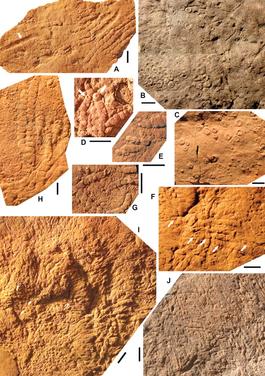Funisia is a genus of animal containing the single species F. dorothea. It is an extinct animal from the Ediacaran biota, discovered in South Australia in 2008 by Mary L. Droser and James G. Gehling.
| Funisia Temporal range: Ediacaran, about | |
|---|---|
 | |
| Funisia specimens, as illustrated in the original article | |
| Scientific classification | |
| Kingdom: | |
| Phylum: | |
| Genus: | †Funisia Droser & Gehling, 2008 |
| Binomial name | |
| †Funisia dorothea Droser & Gehling, 2008 | |
Description
Funisia, a sedentary animal resembling an upright worm,[1] stood about 0.3 m (1 ft 0 in) tall.[2][3][4] Because individuals grew in dense collections of animals the same age, it is believed to have reproduced sexually, as well as reproduced by budding like modern sponges and corals.[3] Although the evolution of sex took place before the origin of animals, and evidence of sexual reproduction is observed in red algae 1,200 million years ago,[5] Funisia is one of the oldest known animals for which there is evidence of sexual reproduction.[4]
Its relationship to other animals is unknown, but it may belong within the Porifera (sponges), Cnidaria,[1] a basal metazoan similar to sponges [6] or an early varisarcan vendobiont.[7]
The genus and species were described in a 2008 paper.[1]
Etymology
The generic name Funisia is after the Latin "rope", and is pronounced to rhyme with Tunisia.[8] The name dorothea is in honour of Dorothy Droser, the mother of Mary L. Droser, one of the scientists who studied the organism.[2]
See also
References
Wikiwand in your browser!
Seamless Wikipedia browsing. On steroids.
Every time you click a link to Wikipedia, Wiktionary or Wikiquote in your browser's search results, it will show the modern Wikiwand interface.
Wikiwand extension is a five stars, simple, with minimum permission required to keep your browsing private, safe and transparent.
